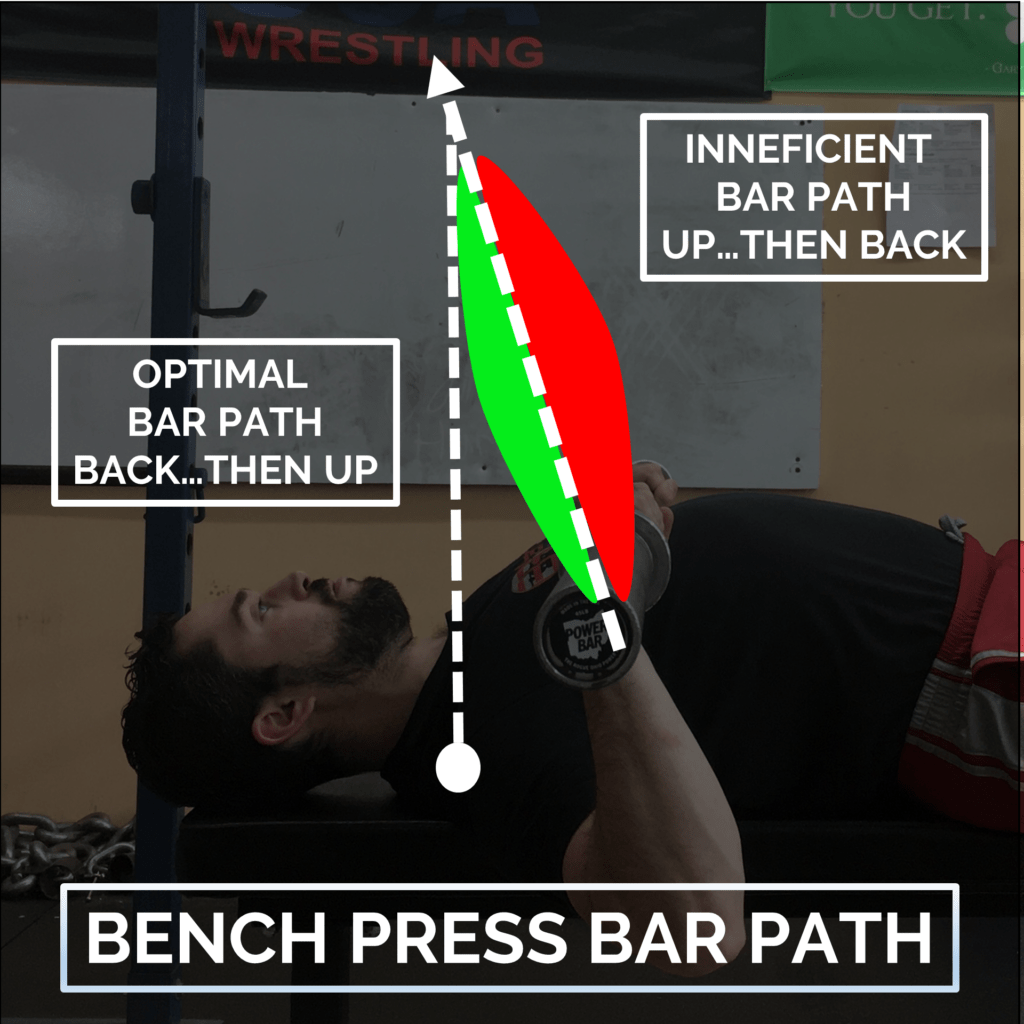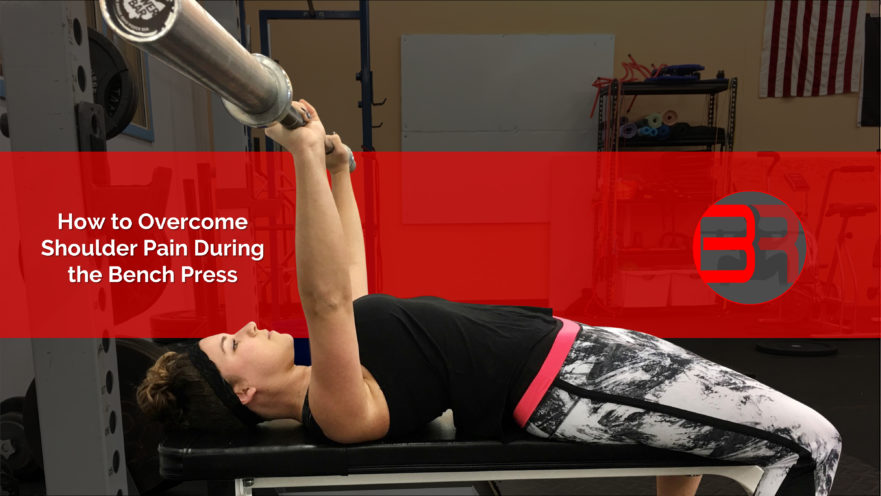Shoulder pain during the bench press can be tricky to manage, especially if it’s been going on for a while. If you feel like you’ve tried everything, from foam rolling to stretching and mobility without any permanent success, you’re in luck. Here is a step-by-step framework to help you finally overcome your shoulder pain!
Optimize Shoulder Blade Position
Before making any other changes on the bench press, you should first make sure your shoulder blades are “retracted” or squeezed together throughout the entire lift. Retracted shoulder blades give you a stable base from which to press and helps optimize the force transfer through the shoulder joint.
One reason you could be having anterior shoulder pain during the bench press, is that you’re allowing your shoulder blades to anteriorly tilt at the bottom of the motion.
This anteriorly tilting of the scapulae at the bottom of the bench press can cause the head of the humerus to push forward into structures that are already sensitized and painful (like the rotator cuff and biceps tendon). Limiting this motion can help reduce your pain.
Correct Your Bar Path to Maximize Efficiency
In order to optimize your bar path during the bench press, you want to bring the barbell down to a point on your mid-low sternum and then press it DIAGONALLY backwards, back to over your shoulder joint. The bar path on a bench press is NOT linear. Take a look at the image below.

Advanced lifters have been shown to press the bar BACK and THEN UP, whereas beginners have a tendency to press UP and THEN back. Cueing a diagonal bar path is usually all that’s needed to help encourage the optimal bar path.
At this point, you may be wondering about how bar path may correlate with shoulder pain during the bench press. Trying to press up and THEN back can often lead to the dreaded sticking point in the middle of the rep, a few inches off of the chest. This can cause more stress on your shoulders than needed because you are unable to overcome the moment arm, or distance from the barbell to your shoulder joint.
Instead, pressing it back and then up in order to efficiently overcome that moment arm in the beginning of the lift will minimize any sticking points or excessive shoulder stress.
Shoulder Abduction Angle and Chest Touch Point
The amount of shoulder abduction at the bottom of the bench press (aka whether your elbows are tucked by your side or flared out) is highly variable based on the individual.
Some will naturally feel better with a wider grip and more elbow flare. Others will feel better with a narrower grip and tucking their elbows closer to the side.
In general though, you want to bring the barbell down to a point on your mid-low sternum, which will create a shoulder abduction angle of about 50-70⁰.

This touch point will help maximize muscle contribution from both the triceps and pectoral muscles. If you bring the bar too LOW, it’s going to be extra work for your shoulders to bring the bar horizontally back to the lockout position.
If you bring the bar too HIGH, you’re now going to have to press through an excessive range of motion. Usually, that happy medium touch point of the mid-low sternum works best.
When to Modify the Grip Width
Sometimes a moderate grip width and touch point on the mid-low sternum doesn’t feel great for some people and can still cause shoulder pain on the bench press. In that case, one thing you can do is slightly modify this position by moving the grip in or out a tad.
Closer grips and more elbow tuck will correlate with a lower touch point on the chest. Wider grips and more elbow flare with correlate with touching the bar higher on the chest. Neither of these are right or wrong per say, rather you have to find what feels best for you.
Altering the grip width is one of the most powerful interventions you can make to help radically change shoulder pain with the bench press.
Optimize the Programming and Dosage
I can’t tell you how many times this factor is overlooked. It is something I repeatedly mention in the Barbell Rehab Workshop, and written about in numerous articles like how to reduce back soreness during the deadlift, or getting rid of hip pain during squats.
If you’re going into the gym every bench press session to see how much you can lift, or how many reps you can achieve at a certain load, you’re not training…you’re TESTING.
If you’re doing this AND you’re experiencing shoulder pain after the bench press, no amount of form optimization is going to help. This is a programming error.
Look at the RPE and Intensity
For those that train based on rate of perceived exertion (RPE) you should strive to get the majority of your bench press working sets in at an RPE 7-8.5. This correlates to about 80-85% 1RM.
Consistently performing too much volume above 85% 1RM or RPE 8.5 may be the reason why you’re always having shoulder pain after bench pressing! Back the intensity down a tad to see if this helps.
When Modifications Don’t Work…Alter the Exercise
Sometimes no amount of form optimization or modification will help reduce shoulder pain from the bench press. In this case, you may want to remove the bench press and change the exercise all together for a period of time.
If you’re having pain just at the BOTTOM portion of the bench press, you can substitute in variations like the floor press or pin press that will remove this portion and allow you to press more tolerably.
If you’re having pain with any barbell variation, you can try doing a dumbbell variation instead. Sometimes people have difficulty tolerating the fixed pronated position of the barbell, but as soon as they can externally rotate the shoulders a bit with a neutral grip dumbbell bench press, it’s instantly pain-free.
Dumbbells give you a LOT more freedom to select the appropriate amount of shoulder abduction that will feel best for you.
Putting it All Together…Practical Solutions
If you’re dealing with shoulder pain during the bench press, there are a lot of modifiable factors that you can change to allow it to be more tolerable. Here’s what I would do, in order of most important to least
- Optimize the form and programming. Make sure you’re keeping your scapulae retracted, pressing in a diagonal bar path, and you’re not performing too much volume at an RPE 8.5 or above.
- Adjust the grip width and chest touch point. Try narrower grips and lower touch points, or wider grips and higher touch points. See if you can find a combination that feels tolerable for your shoulder.
- If you’re still having pain, dose in some variations like floor presses or pin presses that remove the bottom portion of the bench press for 4-6 weeks until the pain calms down.
- If any barbell variations hurts, try using dumbbells instead. Find your optimal hand position and shoulder abduction angle that feels best to you!
Rehab doesn’t need to be fancy folks. There are so many variables that you can tweak that will allow you to continue training, limit deconditioning, and finally overcome shoulder pain during the bench press!

